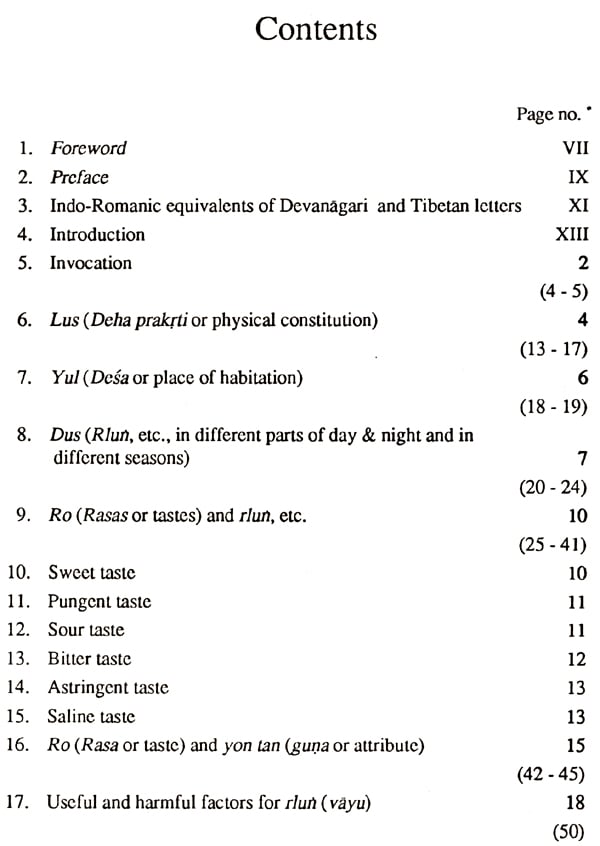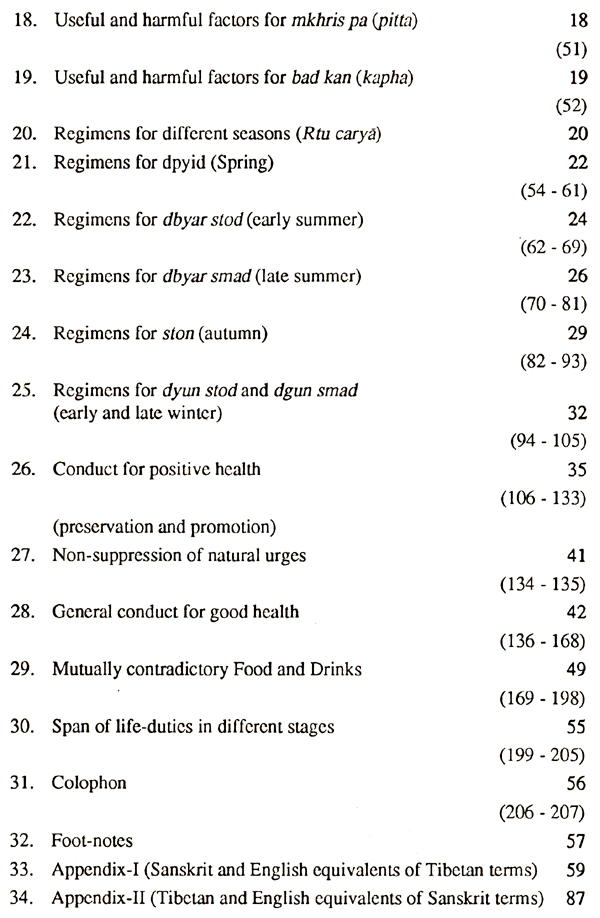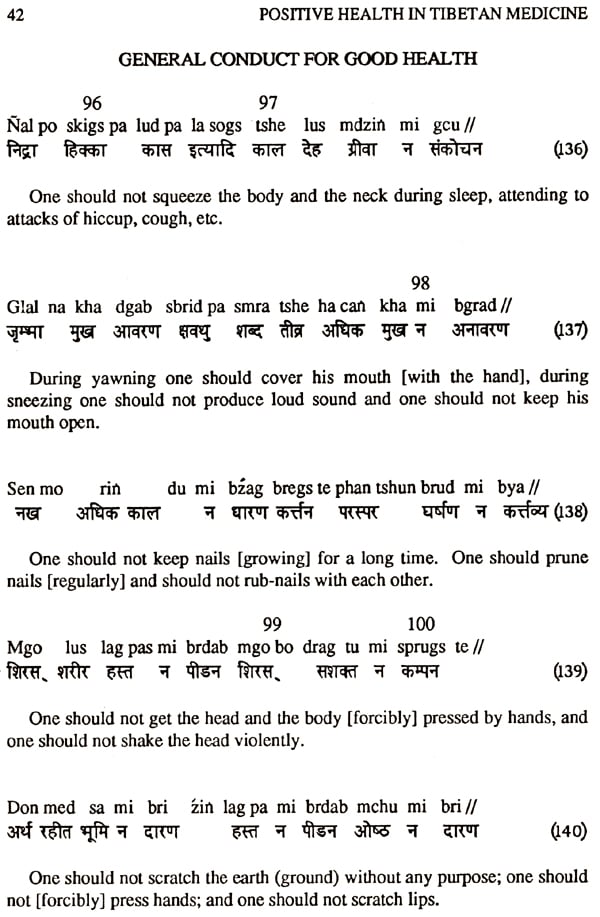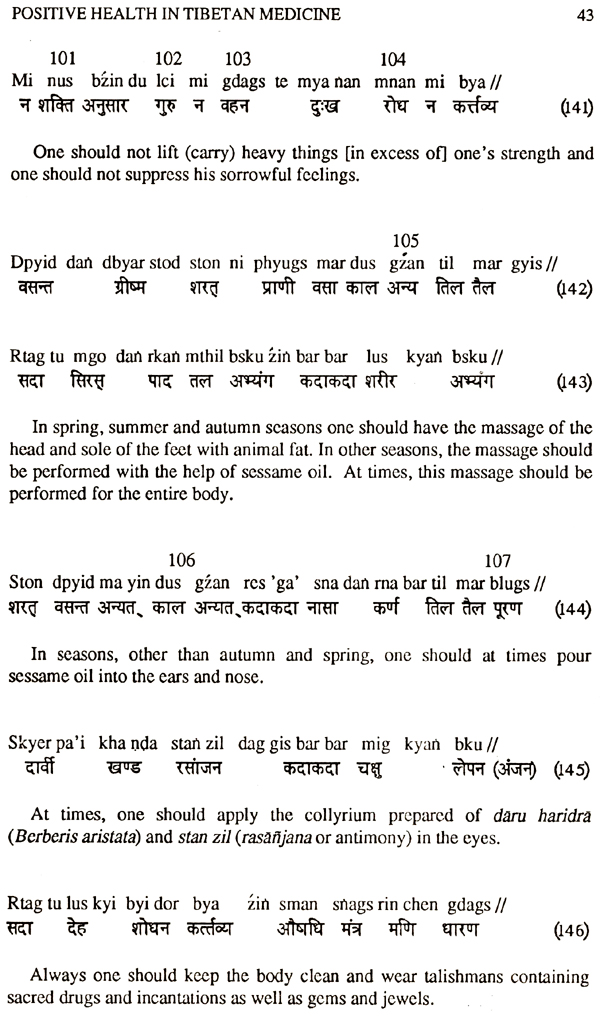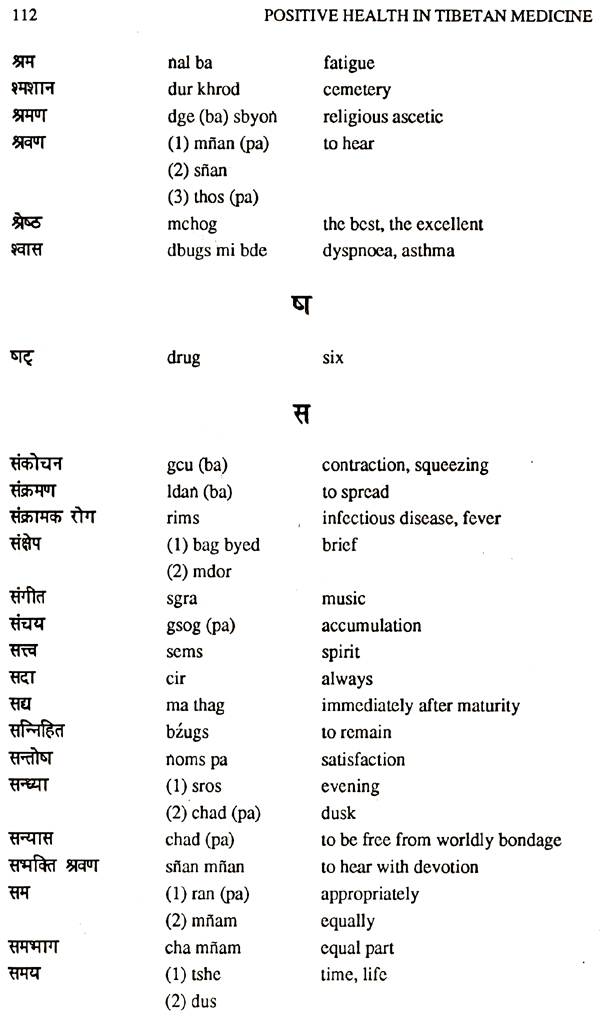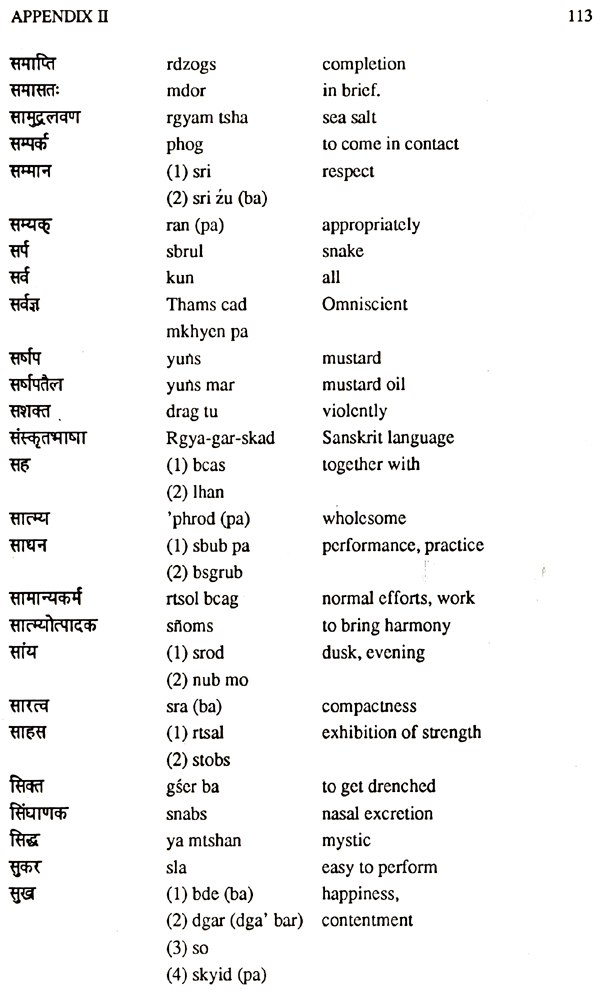
Positive Health in Tibetan Medicine
Book Specification
| Item Code: | NAS151 |
| Author: | Vaidya Bhagwan Dash and Ven. Doboom Tulku |
| Publisher: | Sri Satguru Publications |
| Language: | Sanskrit Text Transliteration with English Translation |
| Edition: | 1991 |
| Pages: | 152 |
| Cover: | HARDCOVER |
| Other Details | 9.00 X 6.00 inch |
| Weight | 290 gm |
Book Description
Positive health is a new concept in Modern Medicine. In the traditional medicine of India and Tibet, a lot of emphasis is laid upon the food, drinks, regimens and conduct for the preservation and promotion of positive health. It is considered to be one of the eight specialised branches of traditional medicine. Food and regimens for different parts of the day (Dinacarya), and night (Ratricarya), and during different seasons (Rtucarya) form the basis of this specialised branch. The religious, social and cultural traditions of Tibet are however, distinct and different. They want an individual to be free from diseases, and mentally and spiritually happy. Therefore, they lay more emphasis upon positive health and prevention of disease for which several measures are adopted in their day to day life. For health, more emphasis is laid upon appropriate diet, drinks and regimens in comparison to drugs and therapies. It is stated, "If a person is on proper diet, etc., then there is no need for medicine and if a person is not on appropriate diet, then there is no need for medicine".
References to positive health are available scattered in different parts of Tibetan and Ayurvedic Medical Works. In the present work, these references are compiled together and it is included as a part of the Tanjur scriptures of Tibetan Buddhism. In brief, this work deals with all the different aspects of positive health and it will be useful to the students and research workers in the field of Medicine in general and in the field of Tibetan Medicine and Ayurveda in particular.
Vaidya Bhagwan Dash has had-an outstandingly brilliant academic career. In addition to graduate and post-graduate qualifications in Ayurveda, he holds a Master's degree in Sanskrit and a Doctorate from University of Delhi. In the course of over thirty years dedicated to research and practice of Ayurveda, Dr. Dash has attended several international conferences and seminars held in Brazil, Mexico, Italy and France, and has written over thirty-eight important publications covering different aspects of Ayurveda and Tibetan Medicines. . He was Deputy Adviser in Ayurvda to the Government of India in the Ministry of Health and F.W. till 1981, when he took voluntary retirement to enable him to devote more time for academic and research activities. As a Consultant in Traditional Medicine of the World Health Organisation, he had paid several visits to Bangladesh, Bhutan, Burma and Mongolia to study and advise on the Health Development Programmes of these countries. Ven. Doboom Tulku is an incarnate Lama, who as a part of his monastic disciplines has conducted intensive studies of religious and non-canonical scriptures. He came to India in 1959, pursued his studies and obtained the degree of Acharya from the Sanskrit University, Varanasi. He has edited, translated and supervised the publications of several books and journals on different aspects of Tibetan religion, tradition and culture. As a close associate of His Holiness the Dalai Lama, he is working as the Director of Tibet House in New Delhi, to promote Tibetan culture and tradition since 1981, through different socio-cultural programmes of Tibet house.
In the Tangyur section of Tibetan scriptures several works on medicine (including Veterinary medicine) are incorporated. There are clear evidences in respect of most of these works that these were originally composed by Indian scholars in Sanskrit and subsequently translated into Tibetan language by Tibetan scholars, in some cases with the help of Indian scholars. Sanskrit originals of most of these works are no more extant. Since these works are in Tibetan language, Scientists, Physicians and well-meaning Research workers in other parts of the world are not able to study them and utilise them for the benefit of the suffering humanity.
The first work in this list, viz., Sbyor-ba brgya-pa or Yoga sataka, with its translation in Sanskrit and English and notes has already been published by the Library of Tibetan Works and Archieves, Dharmashala, India in 1985. The seventh work in this list, viz., Sman-bpyad Yan-lag brgyad-pa'i snin po'i 'grel-pa las Sman-gyi Min-gi Rnam-grans or Vaidyaka Astangahrdayavrttau Bhesaja-Nama-Palyaya has also been published by Classics India Publications, New Delhi in 1986. The present work is placed second in the above mentioned list of works in the Tanjur scriptures and its Sanskrit or English translation is not yet attempted. Since this is an important work dealing with measures for the preservation and promotion of Positive health (which is a new concept in modern medicine) and prevention of diseases, we attempted to bring out its edition with English translation and notes in English.
Several editions (versions) of the Tanjur scriptures are available now. For collating and editing this text, we have used Derge, Narthang and Peking edi-tions and given the variant readings in the foot-notes marked in parenthesis as (D), (N), and (P) respectively. In addition, we were fortunate to get an edition of this work in type print which was edited and published by Prof. J. Cai of the Academy of Traditional Chinese Medicine, Beijing in 1988. Even if Prof. Cai seems to have followed Derge edition, several important variant readings are available in this work which are incorporated in foot-notes with the mark (J).
We very much desired to give the Tibetan text in the original Tibetan script. But, because of non-availability of Tibetan types we had to Romanise them, and in this connection, we have followed the pattern of transliteration approved and adopted by the U.S. Library of Congress. Below each Tibetan term we have given the Sanskrit equivalent (without case endings) in Devanagari. After the English translation of the Tibetan text (and in some cases even before it), we have given brief notes in English to explain the topic.
This work is in verses except the initial invocation, introductory remarks and colophon. In the original Tibetan text, the verses are not numbered. We have numbered each line to facilitate reference and clubbed them together with main-headings or side-headings on the basis of topics discussed. It is perhaps necessary to mention here that in all these editions, there are errors inasmuch as several lines are not complete. Since this is a scriptural work and these errors might have crept into the text by calligraphers or cutters of wooden blocks, we have not taken the liberty to fill up the missing words. However, we have indicated such omissions and errors in our notes under the respective lines of the work.
The biggest hurdle in the translation of Tibetan works in general and medical works in particular is the difficulty in finding both Sanskrit and English equivalents of the Tibetan technical words. Therefore, at the end, we have furnished two indices incorporating such technical terms. In the first appendix, Tibetan terms (though Romanised), are arranged in Tibetan alphabetical or-der. In the second appendix, Sanskrit words (without case endings) are arranged according to the order of Devanagari.
This is only as humble attempt and we do not claim perfection. This can serve as a basic text which can be further improved and corrected by the future Research scholars.
It is a pleasure to observe the successful production of the Vaidya-Jiva-Sutra from its extant Tibetan translation. Vaidya Bhagwan Dash now presents it in a form with Sanskrit words that are equivalent to the Tibetan terms, plus English translation, along with his own learned remarks.
Continuing the practice of Dash's numerous previous works, the names of the three 'closhas,' namely, vayu, pitta, and kapha, are left untranslated. The cogent reason is that the usual translations of the terms as are found in other books are based on the forms of the `dosha-s' after they depart from the body, whereas the terms mainly apply to the functions of the three in the body itself.
The high standard maintained in the present work reflects the many years devoted by Bhagwan Dash to Indo-Tibetan medicine in its various aspects, and on which he has published a number of very useful books. May the readers of this work profit from his admirable and intelligent industry.
In the recent past, modern medicine has made phenomenal progress in eradicating many infectious diseases and controlling several metabolic ailments, notwithstanding the adverse toxic effects of some of the newly discovered remedies. But the basic problem of health lies not in curing diseases, and not even in their prevention because a person who is simply free from diseases is not to be treated as 'healthy' in the real sense of the term. In addition, he should be mentally and spiritually happy to lead a productive and socially useful as well as beneficial life till his inevitable death. He should be an asset with his accumulated experience and not a liability with his invalidating diseases for the society.
Health for All
The World Health Organisation has fixed its goal as "Health for All" by 2000 A.D.. It will be difficult to achieve this aim simply by increasing the number of medical colleges, hospitals and dispensaries and by producing more of doctors and paramedical staff. For this, it is essential to propagate the knowledge of and adopt the measures for the preservation and promotion of Positive Health and prevention of diseases.
Positive Health The concept of "Positive Health" is in its infancy in modern medicine. On the other hand, in Tibetan medicine and in Ayurveda, this aspect, i.e. measures for positive health is more emphasised and elaborately described. Scientists all over the world are evincing keen interest in the Traditional medicines of different countries mainly to find a medicine or therapy for curing such diseases for which modern conventional medicines are not available or they produce adverse reactions as a result of which the patient suffers more because of these toxic reactions than the disease he was suffering from. But the concept of Positive Health dealing with measures to prevent the occurrence of diseases and to make a person lead not only physically but mentally and spiritually happy life is relegated to a position of low priority. The main reason for this neglect is perhaps the absence of commercial value in the propagation of such measures. If a person falls ill, then several people including the scientists who discover new drugs, the industrialists who manufacture them, the physicians who prescribe them and chains of distributors who supply these drugs through their several channels are benefitted. If measures to make a person lead a disease-free and happy life are propagated, then only the individual is benefited. In this materialistic world he is in a minority, and therefore, measures which are useful for him do not attract the elite attention. There is per-haps nothing to be surprised about it.
Distinctive Features of Tibetan Tradition
The religious, social and cultural traditions of Tibet are however, distinct and different. They want an individual to be free from diseases, and mentally and spiritually happy. Therefore, they lay more emphasis upon positive health and prevention of disease for which several measures are prescribed and adopted in their day to day life.
Origin of Diseases According to Caraka (Caraka Sauthita : Vimana 3 : 24) sinful acts give rise to inauspiciousness. During the first age (Satya Yuga) people were enthu-siastic, energetic, pure (free from sinful acts) and therefore powerful. They were endowed with the visions of the gods and divine saints. With the sense of duty, they performed religious rites. They were endowed with truthfulness, charity, self-control, observance of social rules, meditation and celibacy (brahmacarya). They were devoid of fear, attachment, envy, delusion, greed, anger, grief, mental afflictions, abnormal sleep, drowsiness, fatigue, exhaustion, laziness and tendency to collect and accumulate wealth. Because of these features, they were endowed with unlimited span of life. Because of the noble mind, qualities and actions of people, the earth, water, air, etc., were endowed with all good qualities as a result of which excellent tastes, potencies, vipaka (tastes which emerge after digestion) and specific actions were manifested in food grains.
**Contents and Sample Pages**
